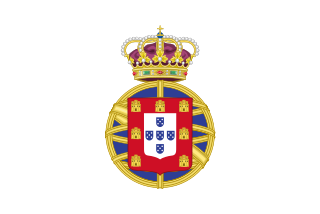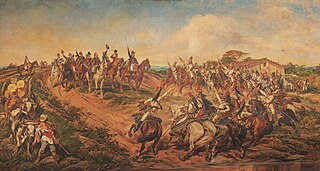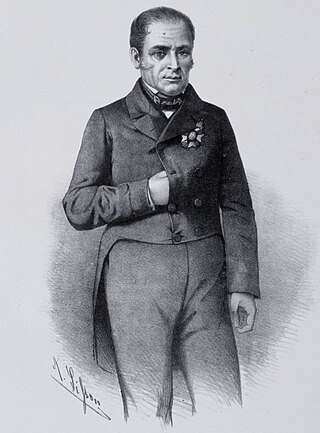Background
In 1807, French forces invaded Portugal due to the Portuguese alliance with the United Kingdom. The prince regent of Portugal at the time, João, had formally ruled the country on behalf of his mother Queen Maria I since 1799. Anticipating the invasion of Napoleon's army, Prince João ordered the transfer of the Portuguese royal court to Brazil before he could be deposed. [1] João elevated Brazil to the condition of a kingdom united to Portugal, creating the United Kingdom of Portugal, Brazil and the Algarves. The royal family stayied in Brazil for 13 years, even after the end of the war in Europe.
In 1820, a political revolution broke out in Portugal, the now King João VI left Brazil and returned to the metropolis, arriving in Lisbon on 4 July 1821. [2] Before his departure, the King appointed his heir apparent, Prince Pedro as regent of the Kingdom of Brazil.
The Portuguese Cortes, a kind of constituent assembly, demanded that Brazil return to its former status as a colony and that the prince regent return to Portugal, but Pedro refused.
The rebellion
After Pedro's decision to defy the Cortes and remain in Brazil, the Auxiliary Division, formed by Portuguese troops led by Avillez, mutinied on January 11 and January 12, 1822 in Rio de Janeiro. The men were divided into two groups: one group in Monte Castelo and another group in Largo do Moura , near the port. They wanted to kidnap the Prince Regent and take him by force to Lisbon. [3] [4] In response to the insubordination, militias were formed by local people, priests and friars. On January 12, Prince Pedro send two men to negotiate an end to the mutiny. After the agreement, the troops withdrew to Vila Real da Praia Grande (present-day Niterói). [5] The clashes between the mutineers and loyal troops to Pedro continued until February 10, when the prince ordered the expulsion of the Auxiliary Division from the kingdom. After a quick attempt to take Morro do Castelo, Avillez withdrew to Ponta da Armação, a peninsula in Vila Real da Praia Grande. He tried an attack on the Santa Cruz da Barra Fortress. However, Brazilian forces had established a naval blockade and occupied the Barretos field, while the fortress repelled the attack, surrounding the Portuguese troops who surrendered. Prince Pedro then "dismissed" the Portuguese commanding general and ordered him to remove his soldiers across the bay to Vila Real da Praia Grande, where they would await transport to Portugal.

DomJohn VI, nicknamed "the Clement", was King of the United Kingdom of Portugal, Brazil and the Algarves from 1816 to 1825. Although the United Kingdom of Portugal ceased to exist de facto beginning in 1822, he remained its monarch de jure between 1822 and 1825. After the recognition of the independence of Brazil under the Treaty of Rio de Janeiro of 1825, he continued as King of Portugal until his death in 1826. Under the same treaty, he also became titular Emperor of Brazil for life, while his son, Emperor Pedro I, was both de facto and de jure the monarch of the newly independent country.

Dona Maria II "the Educator" or "the Good Mother", was Queen of Portugal from 1826 to 1828, and again from 1834 to 1853. Her supporters considered her to be the rightful queen also during the period between her two reigns.

DomMiguel I, nicknamed "the Absolutist", "the Traditionalist" and "the Usurper", was the King of Portugal between 1828 and 1834. He was the seventh child and third son of King John VI and Queen Carlota Joaquina.

Angra do Heroísmo, or simply Angra, is a city and municipality on Terceira Island, Portugal, and one of the three capital cities of the Azores. Founded in 1478, Angra was historically the most important city in the Azores, as seat of the Bishop of the Azores, government entities, and having previously served as the capital city of Portugal during the Liberal Wars. The population in 2011 was 35,402, in an area of 239.00 km2. It was classified as a World Heritage site by UNESCO in 1983.
This is a historical timeline of Portugal.

The history of the kingdom of Portugal and the Algarves, from the First Treaty of San Ildefonso and the beginning of the reign of Queen Maria I in 1777, to the end of the Liberal Wars in 1834, spans a complex historical period in which several important political and military events led to the end of the absolutist regime and to the installation of a constitutional monarchy in the country.

The United Kingdom of Portugal, Brazil and the Algarves was a pluricontinental monarchy formed by the elevation of the Portuguese colony named State of Brazil to the status of a kingdom and by the simultaneous union of that Kingdom of Brazil with the Kingdom of Portugal and the Kingdom of the Algarves, constituting a single state consisting of three kingdoms.

The independence of Brazil comprised a series of political and military events that led to the independence of the Kingdom of Brazil from the United Kingdom of Portugal, Brazil and the Algarves as the Brazilian Empire. It is celebrated on 7 September, the date when prince regent Pedro of Braganza declared the country's independence from the United Kingdom of Portugal, Brazil and the Algarves on the banks of the Ipiranga brook in 1822 on what became known as the Cry of Ipiranga. Formal recognition by Portugal came with the Treaty of Rio de Janeiro, signed in 1825.

The Fort of São João do Arade, sometimes referred to as the Castle of Arade, is a medieval fortification situated in the civil parish of Ferragudo in the Portuguese Algarve municipality of Lagoa.
António Jorge Martins da Mota Veiga was a Portuguese politician and former Minister and law professor.

The Castle of Campo Maior is a medieval military fortification, in the civil parish of São João Bapista, municipality of Campo Maior, part of a first line of defense in the Portuguese Alentejo, oriented towards Spain, in conjunction with the military forts of Ouguela, Elvas, Olivença and Juromenha. It is a walled bulwark of the modern era, highlighted by a Renaissance-era window in the northern tower of the castle. It has been listed as a National monument since 1911.
The Captaincies of the Azores were the socio-political and administrative territorial divisions used to settle and govern the overseas lands of the Azores by the Kingdom of Portugal. These territories, a segment of the Captaincies of the Portuguese Empire, which usually conformed to the individual islands, allowing the stewardship of the King through the Donatary and Captaincy system.

The Fort of São João Baptista is the ruins of a 16th-century maritime fort situated on the western edge of Praia Formoso, in the civil parish of Almagreira, municipality of Vila do Porto, on the Portuguese island of Santa Maria.
Francisco Ornelas da Câmara, nobleman and Azorean politician who was instrumental in the period of the Portuguese Restoration War, being responsible for its declaration in the Azores, and his military campaign against the Spanish-occupied Fortress of São João Baptista (1641-1642).

Jorge de Avilez Zuzarte de Sousa Tavares was a Portuguese military officer and statesman. He fought in the Peninsular War and in the Portuguese conquest of the Banda Oriental.

José Clemente Pereira, known as José Pequeno, was a Portuguese-born Brazilian magistrate and politician who fought in the Peninsular War and of high relevance to the Empire of Brazil, in addition to having been an active member in the Masonic Order.












